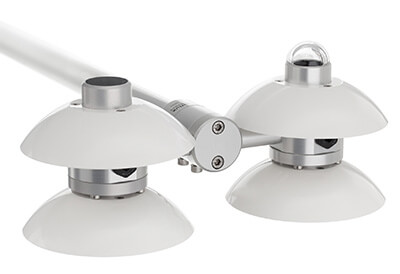In 2009 an article was published by Elsevier for the journal of Agricultural and Forest Meteorology. This article was written by J. M. Blonquist Jr., B. D. Tanner and B. Bugbee. The objective of the study was to compare recently developed net radiometers with older models and to see if there were differences in their measurements. The newer models of the comparison were the NR01 from Hukseflux and the CNR 2 from Kipp & Zonen. The less-expensive older models compared were the NR-Lite from Kipp & Zonen and the Q71 from Radiation and Energy Balance Systemc, Inc. Also, the older but more expensive CNR 1 from Kipp & Zonen was compared.
What is a net radiometer?
Net radiometers are used to measure the net radiation. The net radiation is the difference between incoming and outgoing radiation of a surface. This radiation consists of shortwave and longwave radiation. The net radiation of a surface can be calculated with the following expression:
![]()
with:
Rn = net radiation [W/m2]
SW = shortwave radiation [W/m2]
LW = longwave radiation [W/m2]
Net radiometer test
The models were tested over a uniform turfgrass surface for 33 days during summer. Three replicates of each model were used for the test to filter out defects and outliers. To determine which model had the smallest error, the exact net radiation needed to be known. The exact net radiation was established with a reference pyranometer and infrared measurements of the surface temperature.
The biggest differences between the compared models are the components that they measured.
- The Hukseflux NR01 and the Kipp & Zonen CRN 1 both measure all four components of net radiation independently.
- The Kipp & Zonen CRN 2, the newer and cheaper version, measures net longwave radiation and net shortwave radiation.
- The Kipp & Zonen NR-Lite and the Q71 from Radiation and Energy Balance Systemc, Inc measure net incoming radiation and net outgoing radiation.
The third group, the ‘all-wave radiometers’, were the least accurate. They had offsetting day and night differences that reduced daily total net radiation differences relative to the reference.
The accuracy of the Kipp & Zonen CRN 2 was of average quality when compared to the rest. However, a problem occurred when a ‘flip’ was performed. All instruments were flipped upside down to see if all sensors of a model were equally accurate. When the flip was performed, two of the three CNR 2 models had an error margin of over 5%. This is a problem when non-vegetated surfaces are monitored as radiation reflects of the ground, influencing the sensors facing down.
Conclusion: which net radiometer should you choose?
The Hukseflux NR01 net radiometer and the Kipp & Zonen CRN 1 net radiometer gave the most accurate results, indicating that the most accurate measurements require independent measurements of the four components that determine the net radiation of a surface. The cost of the Hukseflux NR01 is significantly smaller, the Kipp & Zonen CNR 1 is 36,36% more expensive.

Original article: “Evaluation of measurement accuracy and comparison of two new and three traditional net radiometers“.







